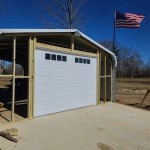Garage Door Gear and Sprocket Kit: Understanding the Heart of Your Opener
The garage door opener is a complex electromechanical system responsible for the convenient and secure operation of a garage door. While often taken for granted, its smooth functioning relies heavily on the integrity of its internal components. Among these, the gear and sprocket kit stands out as a critical assembly. This kit plays a vital role in translating the motor's rotational force into the linear movement needed to raise and lower the door. When this assembly fails, the entire opener can cease to function, leaving the garage door inoperable. This article will explore the composition, function, common issues, and maintenance considerations associated with garage door gear and sprocket kits.
A garage door gear and sprocket kit is not a single, monolithic piece. It is an assembly comprised of several key components working in unison. The primary component is, of course, the gear. This gear, typically made of durable materials like hardened steel or reinforced nylon, is directly connected to the motor shaft. As the motor rotates, it turns the gear. This rotational force is then transferred to the sprocket, which is a toothed wheel designed to engage with the chain or belt that moves the trolley. The trolley, in turn, is connected to the garage door itself. The kit also includes bearings or bushings that provide smooth rotation and reduce friction between moving parts. Grease, provided or applied separately, is crucial for lubricating these components and extending their lifespan. The exact configuration of the gear and sprocket kit can vary depending on the model and manufacturer of the garage door opener, but the underlying principle remains the same: converting rotational motion into linear motion to operate the garage door.
The gear and sprocket kit is responsible for transmitting power from the opener motor to the door. The motor's rotation engages the gear, which then drives the sprocket. The sprocket's teeth engage with the chain or belt of the garage door opener system and this movement causes it to move. This belt or chain is directly connected to the trolley, which then moves along a rail system which provides linear movement to the door connected to it. As the trolley moves, it lifts or lowers the garage door. This mechanical advantage allows the relatively small motor to lift or lower the heavy garage door with ease. The gear ratio is designed to provide the necessary torque, or rotational force, to overcome the weight of the garage door. A properly functioning gear and sprocket kit ensures a smooth, quiet, and reliable operation of the garage door.
Understanding Gear Material and Construction
The materials used in the construction of the gear are crucial to the longevity and performance of the garage door opener. Typically, gears are made from either hardened steel or reinforced nylon. Steel gears offer superior strength and durability, making them suitable for heavy-duty applications and environments where high stress is common. However, steel gears can be noisier in operation. Reinforced nylon gears, on the other hand, offer a quieter operation and are often more cost-effective. They are designed to withstand substantial stress, but their lifespan may be shorter than that of steel gears, particularly in demanding applications. The selection of gear material often involves a trade-off between durability, noise level, and cost. Some manufacturers utilize composite materials that blend the benefits of both steel and nylon, offering a balance of strength, quietness, and cost-effectiveness. The quality of the materials and the precision of the manufacturing process directly impact the reliability and longevity of the gear and sprocket kit.
The construction of the gear involves careful attention to tolerances and dimensions. The teeth of the gear must be precisely shaped and spaced to ensure proper engagement with the sprocket. Any imperfections in the gear's construction can lead to increased wear, noise, and ultimately, failure. The internal structure of the gear is also important. Many gears are designed with internal reinforcement to prevent cracking or deformation under load. The manufacturing process typically involves processes such as machining, casting, or molding, followed by heat treatment to harden the material and improve its wear resistance. The overall construction of the gear is a critical factor in determining its ability to withstand the stresses and strains of daily operation.
Common Issues with Gear and Sprocket Kits
Despite being designed for durability, gear and sprocket kits are subject to wear and tear over time. One of the most common issues is wear on the gear teeth. This wear can be caused by factors such as improper lubrication, excessive use, or misalignment of components. As the gear teeth wear down, they become less effective at engaging with the sprocket, leading to slippage, noise, and eventually, failure. Another common issue is cracking or breaking of the gear. This can be caused by excessive stress, material fatigue, or the presence of debris in the gear mechanism. Cracks can propagate over time, leading to complete failure of the gear. The sprocket can also experience wear and damage, particularly if it is made of a softer material than the gear. The teeth of the sprocket can become worn or broken, leading to similar symptoms as gear wear. Bearings or bushings within the kit can also fail, causing increased friction and noise. A failing bearing can put additional strain on the gear and sprocket, accelerating their wear.
Several symptoms can indicate a problem with the gear and sprocket kit. These include unusual noises coming from the garage door opener, such as grinding, clicking, or squealing. The garage door may also move erratically or fail to open or close completely. In some cases, the motor may run, but the door will not move at all. A visual inspection of the gear and sprocket kit can often reveal signs of wear, damage, or misalignment. It is important to address these issues promptly to prevent further damage to the opener and ensure the safe and reliable operation of the garage door.
Environmental factors can also play a role in the lifespan of a garage door gear and sprocket kit. Extreme temperatures, humidity, and the presence of corrosive substances can accelerate wear and degradation. In coastal areas, salt air can corrode metal components, while in dusty environments, abrasive particles can accelerate wear on the gear teeth. Regular maintenance, including lubrication and cleaning, can help to mitigate the effects of these environmental factors and extend the lifespan of the gear and sprocket kit.
Maintenance and Replacement
Regular maintenance is essential for prolonging the lifespan of the gear and sprocket kit and ensuring the smooth operation of the garage door opener. One of the most important maintenance tasks is lubrication. The gear and sprocket, along with any bearings or bushings, should be lubricated regularly with a suitable grease. The type of grease recommended will vary depending on the manufacturer and the materials used in the kit. It is important to use a grease that is specifically designed for garage door openers, as other types of grease may not provide adequate lubrication or may damage the components.
In addition to lubrication, it is important to inspect the gear and sprocket kit regularly for signs of wear, damage, or misalignment. Look for worn or broken teeth, cracks, and excessive play in the bearings or bushings. Also, check for any debris that may be obstructing the movement of the gear and sprocket. If any issues are detected, they should be addressed promptly. Minor wear may be addressed by cleaning and lubricating the components, while more severe damage may require replacement of the gear and sprocket kit. Replacing a gear and sprocket kit is a relatively straightforward task, but it does require some mechanical knowledge and tools. It is important to follow the manufacturer's instructions carefully and to disconnect the power to the opener before starting any work. If you are not comfortable performing this task yourself, it is best to contact a qualified garage door technician.
When replacing a gear and sprocket kit, it is important to choose a replacement that is compatible with your garage door opener model. Using an incompatible kit can lead to improper operation, damage to the opener, or even safety hazards. It is also important to choose a high-quality replacement kit from a reputable manufacturer. Inferior kits may be made from substandard materials and may not last as long as the original kit. Purchasing a high-quality replacement kit is an investment in the long-term reliability of your garage door opener. Once the new kit is installed, be sure to lubricate all moving parts and test the operation of the opener thoroughly before using it regularly.

041a4885 5 Gear And Sprocket Kit Belt Drive Parts Chamberlain

041a5658 1 Dual Gear And Sprocket Kit Liftmaster

Liftmaster Replacement Gear And Sprocket Kit

041c4220a Chain Drive Gear And Sprocket Kit Parts Chamberlain

Gear Sprocket Kit For Liftmaster 41a5021 41a4252 41a5483 Chamberlain Craftsman

Liftmaster Sears Gear And Sprocket Kit 41c4220a

Keylessoption Garage Door Gear And Sprocket Kit 1 3 2 Hp Opener Systems With 5 Piece Pack

Keylessoption Garage Door Gear And Sprocket Kit 1 3 2 Hp Opener Systems With 5 Piece Pack Black

041a4885 4 Gear And Sprocket Kit Ac Belt Parts Chamberlain

Buy Liftmaster Oem 041a5585 1 Gear And Sprocket Kit 3 4hp








